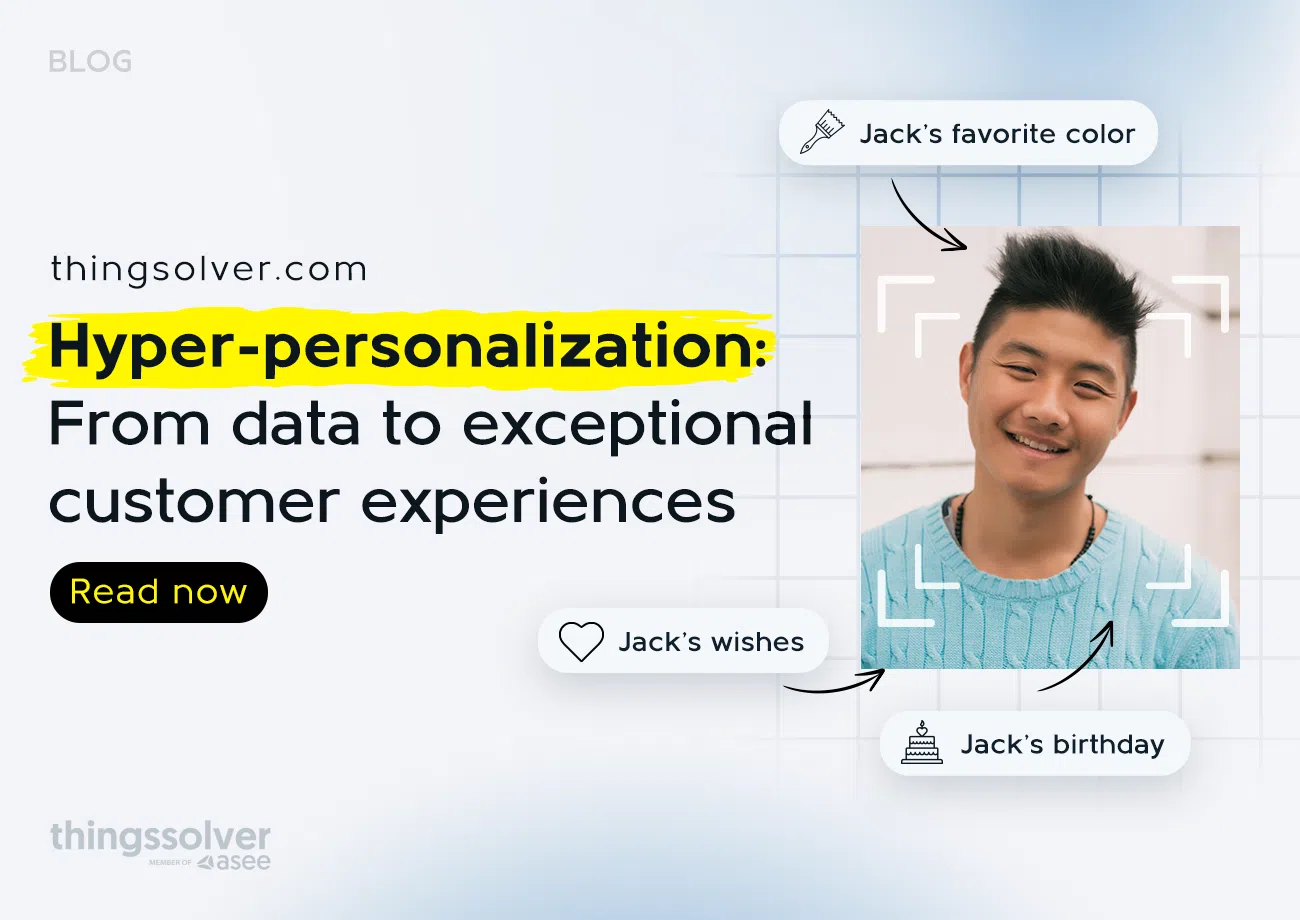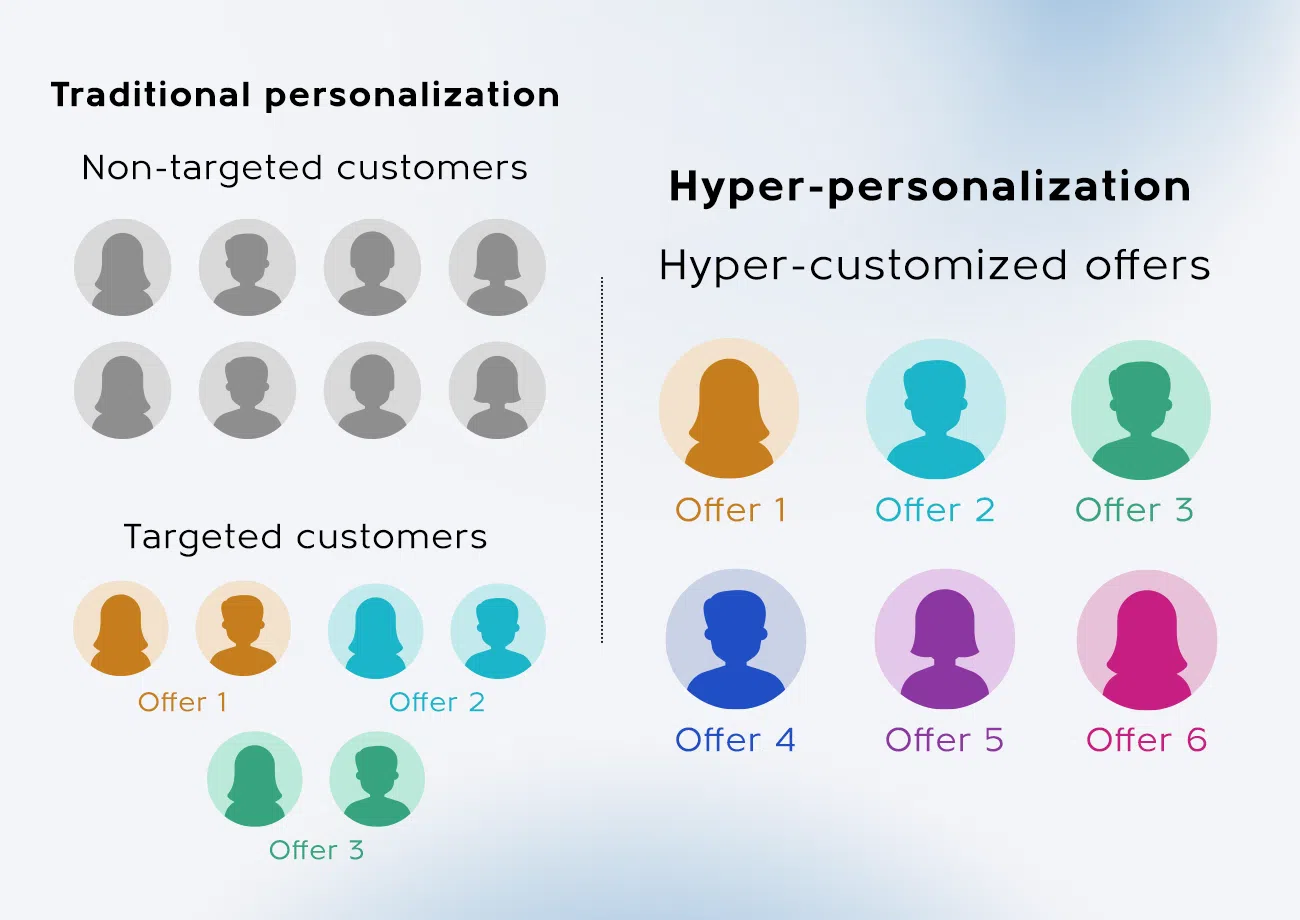What is conversational banking?
The financial industry is undergoing a digital revolution, with traditional methods of banking being replaced by faster, more efficient, and…
Read more09. 07. 2024.

As consumer expectations constantly evolve, your personalization efforts must evolve too.
Enter hyper-personalization — a trend that goes beyond basic customization and has recently gained significant traction.
Stay with us as we define hyper-personalization, explore its benefits, and go through hyper-personalization best practices.
Table of Contents
Hyper-personalization is a form of marketing that uses artificial intelligence (AI) and machine learning (ML) to create highly personalized customer experiences that appeal to each individual’s preferences and interests.
This type of personalization uses real-time data and analytics to help you create services, products, and content specific to each customer. Essentially, hyper-personalization is very reliant on the data you collect about your customers, which is why we can also call it data-driven personalization. Moreover, hyper-personalization helps you craft individual journey maps, which can help you attract more customers, drive profits, and reduce costs in the long run.
But how does it differ from traditional personalization?

Traditional personalization usually involves grouping customers into broad segments based on basic data like age or purchase history. Apart from the “Dear [Name]”, everyone gets similar content or offers, which can feel generic.
According to Pure360 research, only 7% of consumers are more likely to engage with the brand if they address them by name and only 8% of customers are more likely to engage if the brand knows their birthdays.
On the other hand, hyper-personalization relies on advanced AI technology to create experiences for each individual, adapting experiences to create unique touchpoints for everyone.
To help you better understand the difference between these two types of personalizations, let’s look at some examples.
In the first scenario, we have Sarah, an avid online shopper. For years, she received generic promotional emails from her favorite e-commerce store. This is exactly what traditional personalization looks like — segmentation based on broad data that delivers the same content to big customer groups.
Now, let’s imagine Sarah came across a different store that has already embraced hyper-personalization.
From the moment Sarah signs up, this store uses AI and real-time data to understand her preferences and behaviors. One evening, she gets an email showcasing winter jackets in her favorite color and style, along with accessories that complement her recent purchases.
There’s even a discount on an item she viewed but didn’t buy. Intrigued, Sarah makes a purchase. This is hyper-personalization — tailoring every interaction to her unique tastes and behavior.
In banking, we can examine John’s case, who experiences a similar transformation. Traditionally, his bank sends him generic financial advice and offers.
However, once they include hyper-personalization practices, they start analyzing John’s spending patterns and financial goals in real-time. One day, John receives a personalized credit card offer with extra rewards in categories where he spends the most. This targeted approach makes John feel valued and understood.
As you can see, hyper-personalization can be implemented across various industries, such as e-commerce and banking. While traditional personalization lays the groundwork, AI-driven personalization can deliver truly unique experiences.
Now that we’ve seen the effects of hyper-personalization on customers and their experience, let’s see what it can do for you and your business.
In case everything we wrote before hasn’t convinced you to start creating hyper-personalized experiences, we want to highlight a few more benefits that come with it. These include:
With hyper-personalization, you can keep improving your content and offers to encourage your customers to keep buying from you.
According to one Accenture survey, about 72% of consumers say they would only buy more products from brands that offer a personalized experience. When you keep improving and adjusting your offer according to what your customers like, they feel more valued and connected to your brand, which can keep them coming back for more.
Example: Sarah regularly buys at an online store that sends her personalized emails with fashion items in the style and colors she truly likes. She feels the store understands her taste, so she regularly goes back and buys more often.
Hyper-personalization can also smooth out any bumps in the sales funnel and during the buying process. By adjusting to your customers’ preferences and behaviors, hyper-personalization makes it easier and quicker for them to make a purchase.
Example: John is looking for a new laptop online on a particular website. The site remembers his past searches and shows him laptops that match his needs, along with accessories he might like. He finds what he wants without having to search through irrelevant products, making his shopping experience fast and enjoyable.
By offering the right products at the right time, hyper-personalization increases the chances of your customers making a purchase. Sales rise as a result, and clients are gradually encouraged to make larger purchases.
Example: Lisa receives a personalized offer for a skincare product she’s been researching. She buys it and loves it, and the store continues to send her personalized recommendations. She ends up buying other products regularly, increasing her total spend at the store.
You can’t assume that your customers will always buy the same products. As customer preferences change, hyper-personalization helps you stay relevant by continuously adjusting your offer, product, and services to meet new needs and trends.
Example: Mark enjoys personalized music recommendations from a streaming service that adapts to his changing tastes. As his music preferences evolve, the service keeps up, always suggesting fresh tracks he’s likely to enjoy, keeping him engaged and satisfied.
While there are many benefits of hyper-personalization, there are a few challenges.
First, hyper-personalization can be time-consuming and expensive. One of the biggest challenges might be to decide when to implement personalization strategies. Some companies start with anonymous data to personalize experiences, while others prefer to wait and collect more specific insights from customer interactions.
Additionally, customers might feel uneasy about technology predicting their behavior based on the detailed analysis of their digital footprints. To avoid this, you can use permission-based hyper-personalization. This will allow your customers to be aware of and agree to the use of their data, making them feel more comfortable.
Choosing the right approach is crucial for the long-term success of hyper-personalization. Just remember, hyper-personalization benefits must serve you (your company) and your customers.
If you’re serious about implementing hyper-personalization, consider some of the best practices we’ll outline in the following paragraphs.
Of course, what you decide to embrace is entirely up to you, but make sure to consider everything before deciding.
To achieve the best results with hyper-personalization, you should continuously optimize and experiment with your strategies. This involves regularly analyzing how you do things and looking for ways to improve them.
Trying new methods and testing different tactics can help you discover what resonates most with your target audience. With hyper-personalization, your focus is always on the customer and providing them with the best possible experiences, offers, and services.
This ongoing process helps you stay ahead of changing customer preferences and ensures that your personalization efforts remain effective and relevant.
A key component of successful hyper-personalization is collecting and using the right data. The more relevant and detailed the data you collect, the better you can understand and meet individual customer needs. This includes:
Having all this data and using it can help you create highly tailored experiences that make your customers feel understood and valued. When they feel this way around you and your brand, they are more likely to become loyal customers and stay engaged in the long run.
Hyper-personalization requires you to ensure a cohesive customer experience across all your platforms by delivering personalized content consistently.
Whether customers interact with your brand on your website, social media, or mobile app, you should give them a seamless experience that’s entirely tailored according to their preferences and interests. To do this effectively, you should use all the data you’ve collected to personalize every touchpoint, This approach will ensure that each interaction feels relevant and engaging, no matter where it happens.
Constantly testing and refining your hyper-personalized experiences is vital for maintaining their effectiveness.
Feedback and analytics should be your allies in evaluating how well your personalized content resonates with your target audience. They help you identify what’s working and what isn’t so that you can make the necessary adjustments to improve their overall experience.
Continuously refining your approach can help you ensure that your hyper-personalization efforts stay fresh, relevant, and impactful. This also means you can enjoy higher customer satisfaction and loyalty further down the road.
Considering that about 71% of consumers expect brands to deliver highly personalized experiences, hyper-personalization sounds like a decision worth investing in.
We know it can be difficult to stay on top of your personalization game, but we firmly believe that hyper-personalization can help you deliver exceptional experiences and create meaningful connections with your customers for years to come.
If you’re unsure about where to start, partnering with Things Solver can help you with your hyper-personalization efforts. Thanks to our software, Solver AI Suite, we can offer you a collaboration that relies on advanced analytics, powerful experimentation tools, and automated content delivery.
We can work together to help you create and deliver unique, hyper-personalized experiences that resonate with every customer. Ready to explore how we can work together and transform your customer interactions?
Contact us today and let’s discuss your hyper-personalization needs!
The financial industry is undergoing a digital revolution, with traditional methods of banking being replaced by faster, more efficient, and…
Read moreYou’re running a business, constantly looking for ways to cut costs, boost efficiency, and increase revenue. But here’s the harsh…
Read moreAgentic AI will transform industries, but with one important exception — without consolidated data, even the most sophisticated AI systems…
Read more